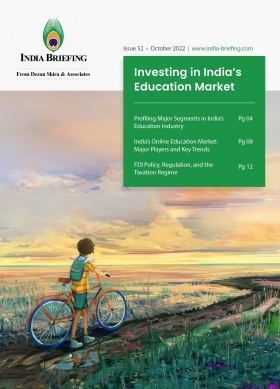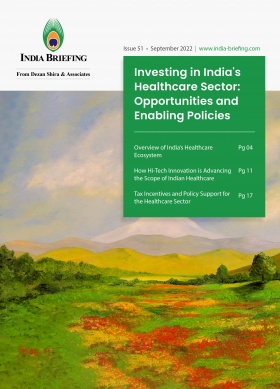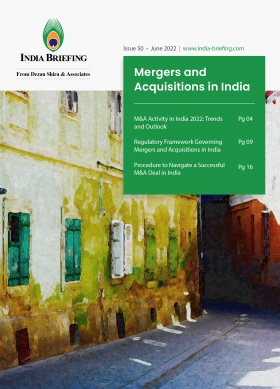Tax and Incentive Policies to Spur Investment in India’s Healthcare Sector
Following the pandemic, India rolled out tax and other incentive policies and reforms to boost the overall capability and investment viability of its healthcare sector and the domestic manufacturing ecosystem linked to healthcare services. Consequently, India’s healthcare sector has advanced its scope of services and affordability when compared to other high performing markets. Among others, this has contributed to the growth of the Indian medical value travel market – poised to reach US$13 billion by 2026. We look at some of the prominent tax and FDI policies and reform initiatives facilitating investment growth in the healthcare sector in India.
Since healthcare is a public good, the Indian government is keen to attract foreign investment and know-how to improve the scope of medical facilities across the country, remove inequalities in accessibility to quality care and emergency services, and reduce import dependencies in critical areas like active pharmaceutical ingredients (APIs) and medical devices.
The government’s digital health mission intends to deliver on targeted reforms, monitor for early disease detection, and reduce scope for unauthorized doctors treating patients, and is among flagship programs for the healthcare sector.
Further, as the focus on health and wellness gains prominence worldwide, it has generated interest in alternative systems of medicine and thus potential for investment and research. The government is keen to capitalize on this trend and has put in place a facilitative policy framework under the Ministry of AYUSH.
We look at the policies promoting the growth and development of the healthcare sector in India in this article.
Relevant tax policies
Tax holiday
The government has provided a tax holiday for private healthcare providers operating 50-bedded (or more) hospitals in non-metropolitan areas, under section 80-IB of the Income-tax Act, 1961. The deduction under this section is available to an assessee whose gross total income includes any profits and gains derived from the business of, among other undertakings, operating and maintaining a hospital located anywhere in India other than the excluded area. Section 80-IB benefits have been extended to new hospitals with 100 beds or more, which are established in rural areas; these hospitals will benefit from 100 percent deduction on profits for five years. A 250 percent deduction is available for approved expenditure on operating technology that facilitates telemedicine services and remote radiology. Domestically manufactured medical technology products have a 15-year income tax exemption.
Goods and services tax (GST) regime
Healthcare education (professional) and training services are exempt from GST in India.
Other GST exemptions for the healthcare sector cover healthcare services by a clinical establishment, or an authorized medical practitioner, or paramedics; services provided by veterinary doctors; blood banks; ambulance services; medical tests; and biomedical waste.
However, as of July 18, 2022, GST at the rate of five percent will be levied on non-ICU hospital rooms charging rent above INR 5,000 per day.
Foreign direct investment (FDI) regime
India permits up to 100 percent FDI under the automatic route in the hospitals segment and medical device manufacturing, which means foreign investors do not require approvals from the Government of India for investment in these areas. In the pharmaceuticals industry, FDI is allowed under the automatic route for up to 100 percent in greenfield projects and 74 percent in brownfield projects. In the AYUSH sector, 100 percent FDI is permitted under the automatic route for the wellness and medical tourism segment. AYUSH refers to the Ayurveda, Yoga and Naturopathy, Unani, Siddha, and Homeopathy systems of alternative medicine.
National policies impacting the healthcare sector
National Health Policy, 2017
The National Health Policy emphasizes greater investment in preventative and primary healthcare, access to and financial protection at the secondary and tertiary care levels, as well as the provision of free drugs, diagnostics, and emergency care services at all public hospitals. Further, the Policy envisages private sector collaboration, including the use of financial and non-financial incentives to encourage participation.
Importantly, the Policy aims to increase government spending on healthcare to 2.5 percent of the GDP by 2025. In Union Budget 2022-23, the government has allocated INR 862.01 billion for the health ministry. Capital expenditure planned under the Department of Health and Family Welfare has increased multi-fold from INR 25.08 billion in FY 2020-21 to INR 56.32 billion for FY 2022-23. As per findings from the Economic Survey 2021-22, the pandemic pushed India’s health expenditure to 2.1 percent of the GDP for the first time.
Ayushman Bharat
It is imperative that adequate investments be made to strengthen India’s primary healthcare delivery systems to boost the country’s preparedness, such as during public health emergencies. Under Ayushman Bharat, the government intends to set up a network of health and wellness centers (HWCs) at the primary care level to promote good health and detect diseases early. The Pradhan Mantri Jan Arogya Yojana (PM-JAY) is another pillar of Ayushman Bharat – a non-contributory government sponsored health insurance scheme that enables access to inpatient healthcare for poor and vulnerable families in secondary and tertiary facilities. 500 million beneficiaries come under this scheme with annual hospitalization coverage up to INR 500,000 per family. Drugs and diagnostics are also provided free of cost to eligible beneficiaries at HWCs under the PM-JAY scheme.
Human resource development
The National Medical Commission Act 2019 has replaced the Medical Council of India and includes a provision for a Medical Assessment and Rating Board (MARB) that will rate institutions on the quality of education and training imparted. The government seeks to implement similar reforms in nursing, dentistry, and allied health fields.
Ayushman Bharat Digital Mission (ABDM)
Launched in September 2021, it seeks to set up a national digital health ecosystem. The mission hopes to establish registries at appropriate levels to provide accurate and consolidated data on clinical establishments, healthcare professionals, health workers, drugs, and pharmacies. Moreover, digital prescriptions can prevent unauthorized medical professionals from prescribing medication to patients. The ABDM also intends to create a unique health ID for every individual, which would enable the tracking of patient case history, including diagnostic tests and reports, etc. Cumulatively, the ABDM initiatives can ensure that qualified professionals get uniform, transparent, and systematized access to information, which in turn will improve the delivery of patient care, both in physical healthcare establishments and remotely via telemedicine platforms.
As of July 28, 2022, 50 digital health services and applications have integrated with the ABDM. The ABDM has also expanded its partners ecosystem to 20 government and 32 private digital health applications. ABDM integration is achieved through the ABDM Sandbox (a digital space for experimentation created for testing integration processes before the digital health product is made live for the actual use). Any digital health service provider/ developer can register on the ABDM Sandbox by following a pre-defined process of integrating and validating their software systems with ABDM APIs. Currently, 919 public and private sector integrators have enrolled under the ABDM Sandbox to integrate and validate their software solutions under the scheme.
Sector-wise enabling policies
Hospitals and infrastructure
Scheme for Financial Support to PPPs in Infrastructure: Introduced in 2006, the scheme supports economically justified but commercially unviable infrastructure projects, to supplement resources for bridging unmet infrastructure needs, and to encourage public-private-partnerships (PPP) in infrastructure projects. Under this scheme, 64 projects have been approved with a total project cost of INR 342.28 billion and viability gap funding (VGF) of INR 56.39 billion. A sum of INR 21 billion has been allocated for VGF in social infrastructure projects till 2024-25, split into two sub-schemes, as per the Niti Aayog. The first sub-scheme is for a broad range of social sectors, such as wastewater treatment, water supply, solid waste management, health, and education. Eligible projects are those with financing challenges and insufficient revenue streams to recover capital costs. The Central Government can provide a maximum of 30 percent of capital cost as VGF with the State Government/Sponsoring Central Ministry/Statutory Entity providing an equivalent additional amount (up to 30 percent of the capital cost).
The second sub-scheme is for pilot projects in the health and education sectors that suffer from insufficient revenue streams to recover operational costs fully, in addition to capital costs. The Central Government will provide a maximum of 40 percent of the capital cost of such projects. In addition, it could provide a maximum of 25 percent of the operational costs of the project during the first five years of commercial operations. The State Government can also provide an equivalent amount – at a maximum of 40 percent of capital cost and 25 percent of operational costs for the first five years.
Health insurance
FDI relaxation: The Insurance (Amendment) Act of 2021 increased the FDI cap for the insurance sector from 49 percent to 74 percent. For intermediary services like insurance brokers, re-insurance brokers, insurance consultants, corporate agents, third party administrators, surveyors, and loss assessors – 100 percent FDI under the automatic route has been permitted since 2020.
Relaxation of approval norms for some products: The Insurance Regulatory and Development Authority of India (IRDAI) has extended the ‘Use and File’ procedure for all health insurance products. This means that insurers can sell innovative and customized products after filing with the regulator and taking advantage of changes in market dynamics, instead of waiting for approvals. However, it will necessitate a robust product development, pricing, and policyholder protections regime by the insurance company board. The Project Management Committee (PMC) of the insurance provider must ensure compliance to the policy of the board while giving approval to new products or signing off on the modification of existing products. Insurance companies must file the proposed name of the product, date of approval by PMC, and obtain the Unique Identification Number (UIN). Thereafter, they must file the product along with documents specified in the Consolidated Guidelines on Product Filing in Health Insurance Business, which were published July 22, 2020 – with the IRDAI within seven days of launching that product.
Pharmaceuticals and biotechnology
Reforms: These include constituting a committee to facilitate inter-ministerial coordination, integration of portals of different departments into a single online platform for tracking the application status, and the delegation of reviewing powers to institutional committees.
New Drugs and Clinical Trials Rules, 2019: Approvals will be granted (or provisionally granted) within highly competitive timelines. New drugs approved for use in specified developed markets will be automatically permitted in India if the global drug trials had included Indian patients. The Rules contain safeguard mechanisms to ensure adherence to due protocols and accountability by clinical trial sponsors and investigators. The government also seeks to promote India as a clinical trial hub and set up animal-testing and biocompatibility testing laboratories.
Production-linked incentive (PLI) schemes: Multiple schemes to boost manufacturing for domestic use and exports have been launched under the PLI umbrella.
Initiatives for biotechnology segment: For strengthening India’s biotechnology capabilities, the government has set up the Biotechnology Industry Research Assistance Council (BIRAC), Bio-NEST, and BioTech Science Clusters. BIRAC is established as a not-for-profit section 8, Schedule B, public sector enterprise, by the Department of Biotechnology (DBT) as an interface agency to strengthen and empower emerging biotech enterprises to undertake strategic research and innovation and address nationally relevant product development needs. The development of India’s first indigenously developed DNA vaccine candidate against COVID-19, ZyCoV-D, was supported by the National Biopharma Mission under the aegis of BIRAC and the DBT. Bio-NEST provides incubation space to start-ups and entrepreneurs and connects industry with academia. Four bio-clusters have been set up at Faridabad, Bangalore, Kalyani, and Pune to catalyze R&D and entrepreneurship.
Support for indigenous vaccine development and testing: Ind-CEPI mission aims to achieve epidemic preparedness through rapid vaccine development through a dedicated Program Management Unit (PMU) at the Biotechnology Industry Research Assistance Council (BIRAC). The Ind-CEPI Mission was approved on March 27, 2019 – with a total cost INR 3.129 billion – under the supervision of the Department of Biotechnology, Ministry of Science and Technology.
COVID Suraksha Mission: Has a financial outlay of INR 9 billion.
Medical devices, equipment, and diagnostics
Medical Devices Rules (MDR), 2017: Coming into force January 2018, the MDR, 2017 expanded India’s previous regulatory coverage of only 15 categories of devices and aligned with international best practices. Under MDR 2017, devices are classified and regulated as per their risk profile. To ensure compliance with the highest quality standards and establish credentials of manufacturers, the Rules implement a registration regime that is to be followed up by an application for license with the Central Drugs Standard Control Organization (CDSCO. The process of applying for a manufacturing license is streamlined through an online electronic platform. Regulators intend for the medical device manufacturing ecosystem in India to be quality driven, performance-oriented, safe, and transparent. The government amended the definition of medical devices in 2020 and inserted Chapter III A in the MDR, 2017 through the Medical Devices (Amendment) Rules, 2020 – which came into effect in April that year. Finally, as per industry analysts, the Rules make ISO 13485 (quality management system) a pre-condition for registration, thereby ensuring Indian medical device makers are globally competitive.
National Essential Diagnostics List (NEDL): This has been implemented to improve the availability of quality diagnostics across health facilities in India. The NEDL also aims to bridge the existing regulatory system’s gaps which may miss coverage of certain medical devices and in-vitro diagnostic devices (IVD). The essential diagnostics list (EDL) published by the World Health Organisation (WHO) is a reference point for the NEDL.
Manufacturing ecosystem cluster development: Medical device parks are being developed around five device manufacturing clusters in India. These parks will provide all the essential infrastructure, allowing companies to ‘plug and play’. In 2019, Andhra Pradesh, Telangana, Tamil Nadu, and Kerala were given the green light to establish new medical devices parks.
The Andhra Pradesh MedTech Zone (AMTZ) has nurtured institutions like the Kalam Institute of Health Technology, Indian Biomedical Skill Consortium, Medivalley, and Biovally Incubation Council, which provide support for policy initiatives as well as consultancy on healthcare projects in the country, as per the Niti Aayog.
PLI Scheme: A PLI scheme for manufacturing of medical devices in four identified categories has been announced as well as a scheme for the promotion of medical devices parks.
Quick glance: PLI schemes relevant to India’s healthcare sector
Medical value travel (MVT)
Accreditation regime: India has about 40 Joint Commission International (JCI)-accredited hospitals and 1400+ National Accreditation Board for Hospitals & Healthcare Providers (NABH)-accredited hospitals. Clinical outcomes in India’s leading hospitals are at par with internationally recognized facilities. India also has a large pool of highly qualified doctors and paramedics who have fluency in English.
e-Visa: The government has introduced a medical visa and medical attendant visa regime with e-visas offered to 150+ countries within 24-48 hours. Ayurveda treatment has also been included in the medical visa category. The medical visa and medical attendant visa allow multiple entries and long-term stay.
FDI: 100 percent FDI is permitted in the wellness and medical tourism segment under AYUSH.
Regulating alternative medicine: The Ministry of AYUSH has directed state governments to implement the guidelines for accreditation of Ayurveda and Panchkarma Centers, so they can fulfil their potential for AYUSH-related therapies for chronic diseases.
Policy lessons for India from Asian healthcare majors
There are many valuable lessons for India from other Asian countries that have successfully established themselves as an investment hub in the healthcare sector:
- Unified regulatory framework to remove multiplicity and promote cluster-based developments: China restructured its food and drug regulatory body to form a single agency to streamline the governing regime and reduce the drug approval time.
- Support in healthcare insurance and streamlining medical device regulations: Singapore’s facilitative policies and model of co-payment, in which people share the expense of their care along with government subsidies, have aided in reducing out-of-pocket expenditure.
- High tax incentives: Malaysia is providing high tax incentives to promote investments in the healthcare sector including customized incentives for large ticket investments, 10-year tax holiday, access to ASEAN markets through free-trade agreements, duty exemptions, etc.
About Us
India Briefing is produced by Dezan Shira & Associates. The firm assists foreign investors throughout Asia from offices across the world, including in Delhi and Mumbai. Readers may write to india@dezshira.com for more support on doing business in in India.
We also maintain offices or have alliance partners assisting foreign investors in Indonesia, Singapore, Vietnam, Philippines, Malaysia, Thailand, Italy, Germany, and the United States, in addition to practices in Bangladesh and Russia.
- Previous Article India’s Tax Authority Extends TDS Filing Deadline for Non-Salary Transactions to Nov. 30
- Next Article Digital Rupee Pilot Launch by the RBI on November 1, Targeting Wholesale Segment












